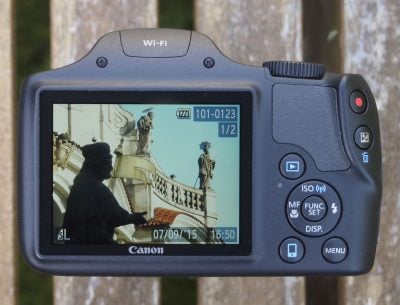Canon PowerShot SX530 HS review
-
-
Written by Ken McMahon
Quality
Canon SX530 HS vs Canon SX410 IS vs Nikon L840 quality results
To compare real-life performance, I shot this scene with the Canon PowerShot SX530 HS, the Canon PowerShot SX410 IS and the Nikon COOLPIX L840 within a few moments of each other, using their best quality JPEG settings and at their base sensitivity settings. For this test the cameras were mounted on a tripod and image stabilisation was disabled. The cameras were zoomed in to provide the same field of view, the ISO sensitivity was manually set to the lowest available setting and Program Auto mode was selected for the exposure.
At its base 100 ISO setting the PowerShot SX530 HS selected an exposure of 1/640 at f4. The PowerShot SX410 IS chose 1/800 at f4 and the COOLPIX L840 chose 1/100 at f3 at its base 125 ISO sensitivity setting.
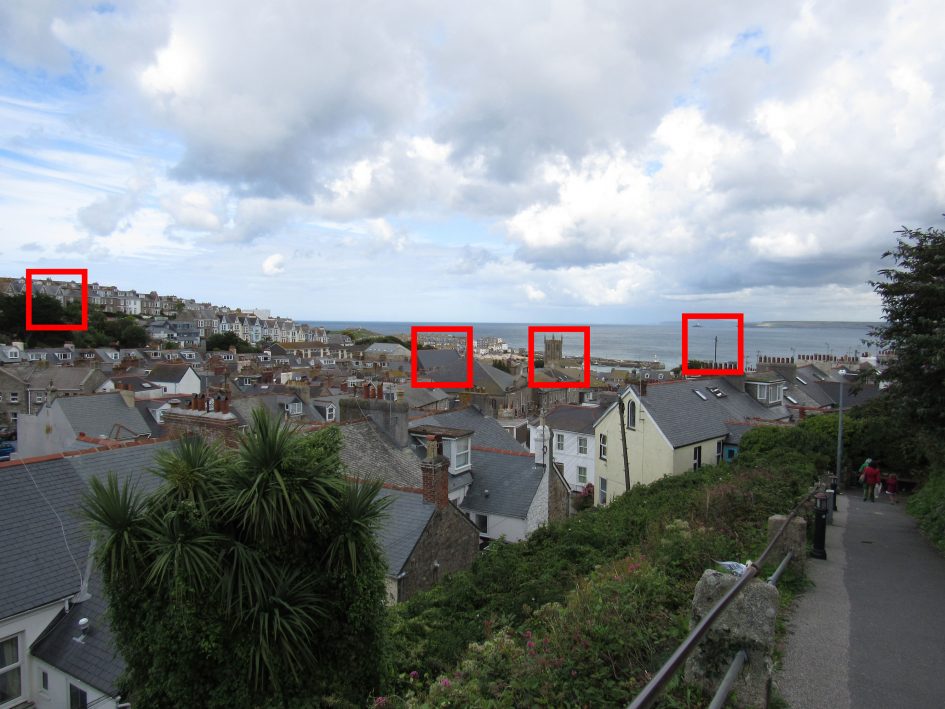
The PowerShot SX530 HS crops look pretty good overall. The first crop isn’t the best one, but things improve markedly in the second crop where there’s a good level of fine detail visible and nice clean edges on the window frames. In the third crop you can just about make out the hands on the church clock, but there’s clearly more detail in the stonework and those foreground roofs than is being resolved by the SX530 HS’s lens and sensor.
Moving on to the fourth and final crop, the lighthouse is a cleanly defined white column and there’s also plenty of detail in the foreground chimney pots, but the pole in the foreground looks a little bit clumpy and has a slight halo. That said, the 16 Megapixel sensor in the SX530 HS produces much cleaner looking crops at 100 ISO with correspondingly more detail than the 20 Megapixel CCD sensor in the PowerShot SX410 IS. The same goes for the 16 Megapixel COOLPIX L840, though the quality margin here is narrower. The other thing that works in favour of the SX530 HS and COOLPIX L840 is that they employ CMOS sensors designed for lower noise output. Given their markedly better performace outdoors at their base ISO sensitivity settings it’ll be interesting to see what happens in low light when it becomes necessary to increase the sensitivity.
Before that you can scroll down to see how these models compare at the middle of their zoom ranges and when fully zoomed in.

Above left: Canon PowerShot SX530 HS at 4.3mm (24mm equivalent) f4, 100 ISO. Above center: Canon PowerShot SX410 IS at 4.3mm (24mm equivalent) f4, 100 ISO. Above right: Nikon COOLPIX L840 at 4.1mm (24mm equivalent) f3, 125 ISO.

Above left: Canon PowerShot SX530 HS at 4.3mm (24mm equivalent) f4, 100 ISO. Above center: Canon PowerShot SX410 IS at 4.3mm (24mm equivalent) f4, 100 ISO. Above right: Nikon COOLPIX L840 at 4.1mm (24mm equivalent) f3, 125 ISO.

Above left: Canon PowerShot SX530 HS at 4.3mm (24mm equivalent) f4, 100 ISO. Above center: Canon PowerShot SX410 IS at 4.3mm (24mm equivalent) f4, 100 ISO. Above right: Nikon COOLPIX L840 at 4.1mm (24mm equivalent) f3, 125 ISO.

Above left: Canon PowerShot SX530 HS at 4.3mm (24mm equivalent) f4, 100 ISO. Above center: Canon PowerShot SX410 IS at 4.3mm (24mm equivalent) f4, 100 ISO. Above right: Nikon COOLPIX L840 at 4.1mm (24mm equivalent) f3, 125 ISO.
Canon SX530 HS vs Canon SX410 IS vs Nikon L840 quality at 300mm equivalent
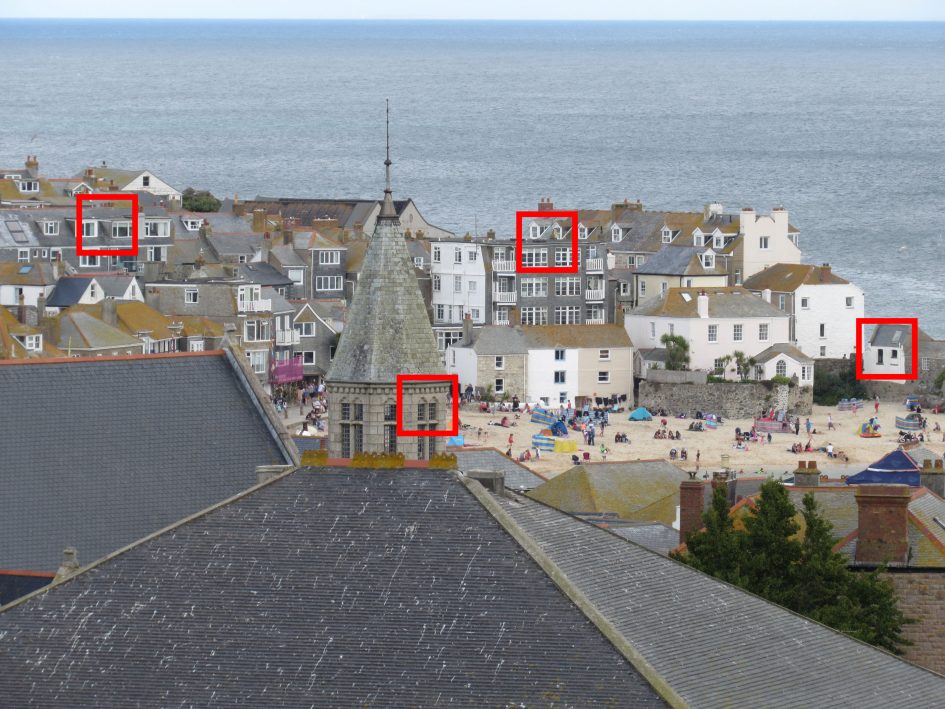
The image above was taken with the Canon PowerShot SX530 HS zoomed in to around 300mm equivalent. As before the camera was mounted on a tripod with the stabilisation turned off and the exposure was set automatically. The crops are taken from the areas marked in red.
At this mid range focal length the crops from the SX530 HS look a little lacking in contrast, particularly the first and last ones from close to the frame edge. At the wide angle setting there’s a clear difference in quality between the SX530 HS crops and those from the SX410 IS and, to a lesser extent the COOLPIX L840. Here though, it’s much harder to spot a quality difference. Yes, the SX410 IS crops are noisier, but the detail is larger and you can see more of it. The SX530 HS crops still look better to me than the COOLPIX L840 ones, though. The latter look very soft and lacking in detail at this focal length and there’s also some colour fringing which is particularly noticeable in the final COOLPIX L840 crop.

Above left: Canon PowerShot SX530 HS at 54mm (301mm equivalent) f5.6, 100 ISO. Above center: Canon PowerShot SX410 IS at 56mm (312mm equivalent) f5.6, 100 ISO. Above right: Nikon COOLPIX L840 at 59mm (335mm equivalent) f5.8, 125 ISO.

Above left: Canon PowerShot SX530 HS at 54mm (301mm equivalent) f5.6, 100 ISO. Above center: Canon PowerShot SX410 IS at 56mm (312mm equivalent) f5.6, 100 ISO. Above right: Nikon COOLPIX L840 at 59mm (335mm equivalent) f5.8, 125 ISO.

Above left: Canon PowerShot SX530 HS at 54mm (301mm equivalent) f5.6, 100 ISO. Above center: Canon PowerShot SX410 IS at 56mm (312mm equivalent) f5.6, 100 ISO. Above right: Nikon COOLPIX L840 at 59mm (335mm equivalent) f5.8, 125 ISO.

Above left: Canon PowerShot SX530 HS at 54mm (301mm equivalent) f5.6, 100 ISO. Above center: Canon PowerShot SX410 IS at 56mm (312mm equivalent) f5.6, 100 ISO. Above right: Nikon COOLPIX L840 at 59mm (335mm equivalent) f5.8, 125 ISO.
Canon SX530 HS vs Canon SX410 IS vs Nikon L840 quality at 855mm equivalent
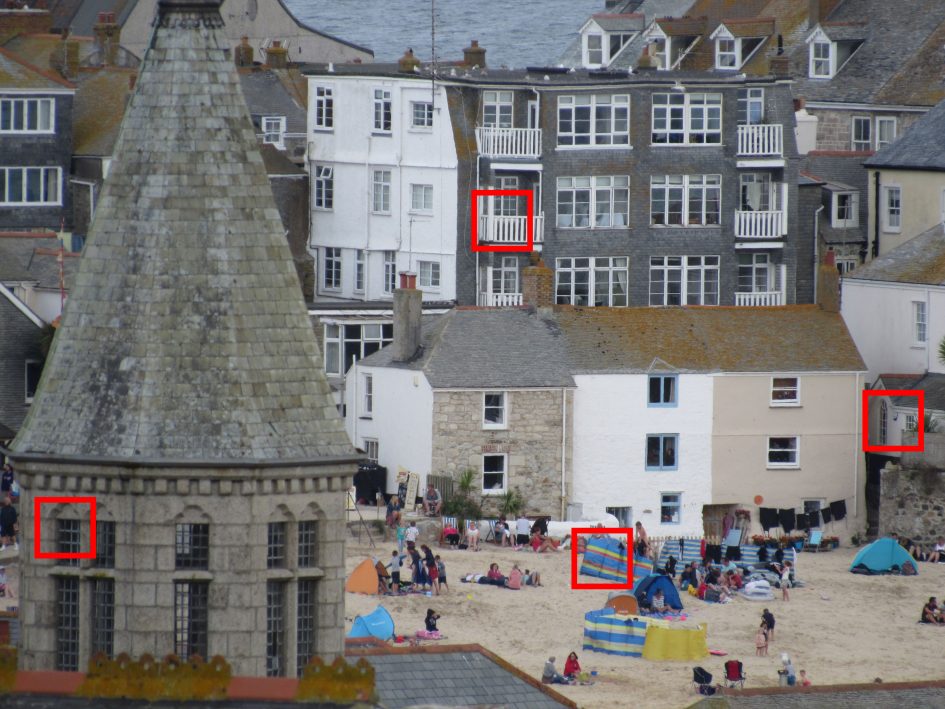
For this final test, I zoomed all three cameras in to around 855mm equivalent to match the maximum focal length of the Nikon COOLPIX L840. This is just a tad short of the 960mm maximum zoom range of the SX410 IS (100mm may sound like a lot, but is actually a small difference in terms of field of view at this focal length). The PowerShot SX530 HS on the other hand has a significantly longer maximum focal length of 1200mm equivalent. Once consequence of this that’s worth noting is that while the PowerShot SX410 IS and COOLPIX L840 maximum aperture’s are f6.3 and f6.5 respectively, the PowerShot SX530 HS can manage nearly a half stop brighter at f5.6.
The story here is much the same as at the other end of the zoom range, the crops from the PowerShot SX530 HS are a tiny bit softer than those from the SX410 IS, but there’s less noise and though it’s smaller the detail is sharper. So it’s a clear win on image quality terms for the SX530 HS, with the Nikon COOLPIX L840 in second place and the noisier PowerShot SX410 IS third. As always though, it’s worth bearing in mind that these differences only reveal themselves at, or close to, 100 percent viewing sizes, so unless you plan on making big prints image quality may not be a major influence on your buying decision.

Above left: Canon PowerShot SX530 HS at 152mm 848mm equivalent) f5.6, 100 ISO. Above center: Canon PowerShot SX410 IS at 150mm (840mm equivalent) f6.3, 100 ISO. Above right: Nikon COOLPIX L840 at 152mm (855mm equivalent) f6.5, 125 ISO.

Above left: Canon PowerShot SX530 HS at 152mm 848mm equivalent) f5.6, 100 ISO. Above center: Canon PowerShot SX410 IS at 150mm (840mm equivalent) f6.3, 100 ISO. Above right: Nikon COOLPIX L840 at 152mm (855mm equivalent) f6.5, 125 ISO.

Above left: Canon PowerShot SX530 HS at 152mm 848mm equivalent) f5.6, 100 ISO. Above center: Canon PowerShot SX410 IS at 150mm (840mm equivalent) f6.3, 100 ISO. Above right: Nikon COOLPIX L840 at 152mm (855mm equivalent) f6.5, 125 ISO.

Above left: Canon PowerShot SX530 HS at 152mm 848mm equivalent) f5.6, 100 ISO. Above center: Canon PowerShot SX410 IS at 150mm (840mm equivalent) f6.3, 100 ISO. Above right: Nikon COOLPIX L840 at 152mm (855mm equivalent) f6.5, 125 ISO.
Next scroll for my Canon SX530 HS noise results, skip to my Canon SX530 HS sample images, or head straight to my verdict.
Canon SX530 HS vs Canon SX410 IS vs Nikon L840 noise results
To compare noise levels under real-life conditions, I shot this scene with the Canon PowerShot SX530 HS, the Canon PowerShot SX410 HS and the Nikon COOLPIX L840 within a few moments of each other at each of their ISO settings. All three cameras were set to their best quality JPEG modes and mounted on a tripod and stabilisation was disabled.
The cameras were zoomed in to provide the same field of view, the ISO sensitivity was manually set to the lowest available setting and Auto mode was selected for the exposure.
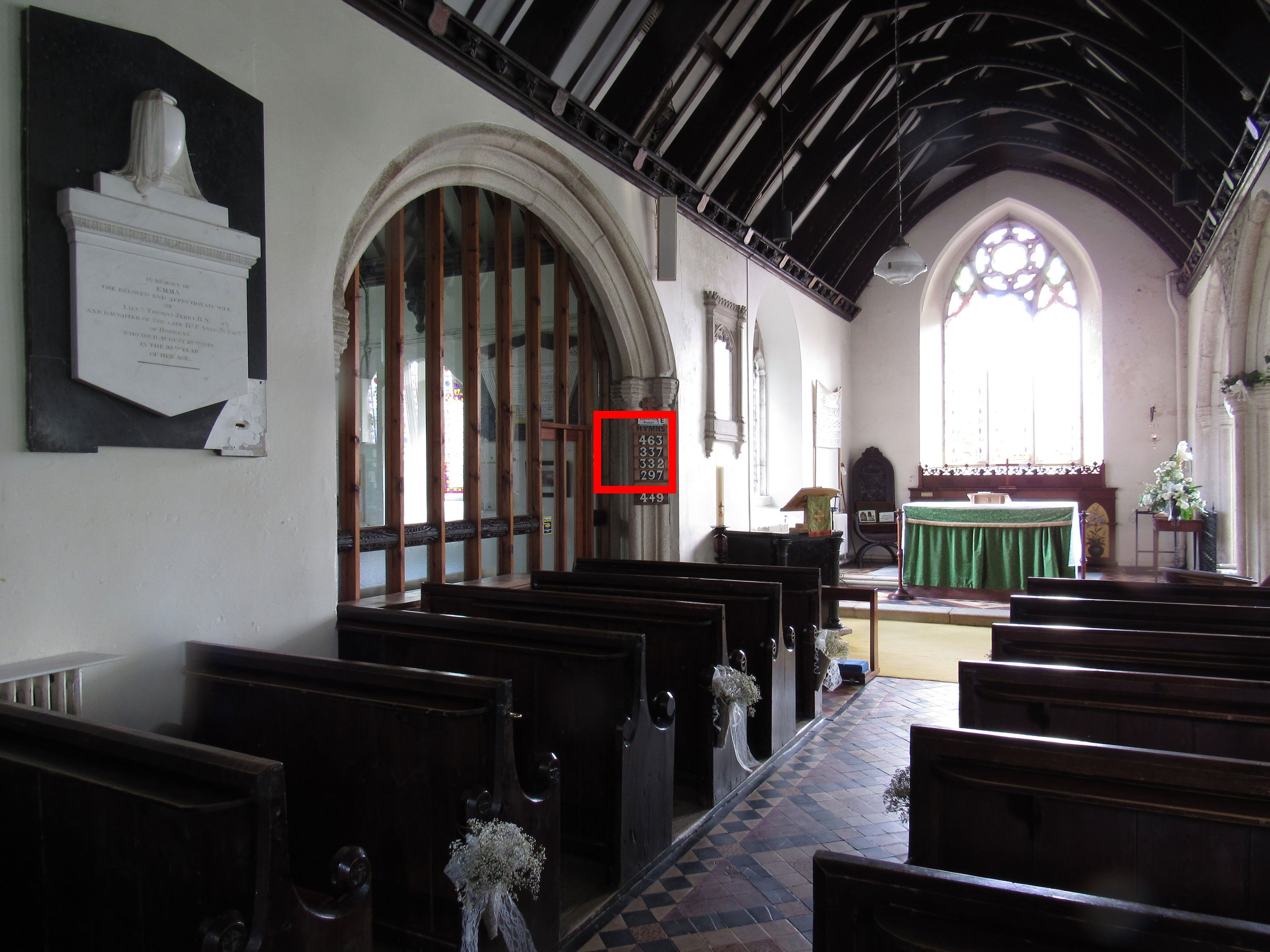
With the sensitivity manually set to 100 ISO the PowerShot SX530 HS set an exposure of 0.4s at f3.4. The SX410 IS chose an exposure of 0.4s at f3.5 and at 125 ISO the COOLPIX L830 selected 1/5 at f3. The crops below are selected from the area marked in red above.
The 100 ISO crop from the PowerShot SX530 HS looks relatively noise free. You can spot a little bit of texture in the white label at the top of the Hymn board, but overall it’s pretty clean with a good level of detail. At 200 ISO the noise is more apparent and you don’t have to go looking for it, at least on these 100 percent crops. That’s a good argument for sticking to the base 100 ISO sensitivity setting whenever possible and the SX530 HS’s Aperture priority exposure mode gives you the opportunity to do that, by setting the aperture as wide as it will go – something you can’t always rely on with the Auto only modes on the SX410 HS and COOLPIX L840.
Beyond 200 ISO there are linear increases in the noise but there’s still plenty of detail in the 800 ISO crop which you’d get away with a full sized print from. That’s not the case for 1600 ISO which is looking at bit grungy at 100 percent, though it looks fine at smaller sizes. The 3200 ISO setting still has plenty of image detail and is well worth having for those low light shots you’ll want to keep regardless of the quality.
The PowerShot SX410 IS’s 20 Megapixel CCD sensor produces a smaller crop area with larger detail than the 16 Megapixel sensors of the PowerShot SX530 HS and COOLPIX L840. As with the outdoor test results, the 100 ISO crops from the PowerShot SX410 IS looks quite noisy. The noisier base level and the larger noise increments – mean that the PowerShot SX410 IS crops are all noisier throughout the range than those from the SX530 HS and COOLPIX L840. But while the gap is relatively small at the lower end of the range by 400 ISO I’d say there’s a one stop difference – in other words the 400 ISO crop from the SX410 IS looks simialr to the 800 ISO crop from the SX530 HS.
The COOLPIX L840’s sensor shares the same 16 Megapixel resolution as the PowerShot SX530 HS’s and both are CMOS sensors. Both sets of crops look very similar in terms of noise, though the COOLPIX L840’s 1600 ISO crop looks a little clumpier. While there’s little difference in the noise output of the two sensors bear in mind what I’ve already mentioned about Aperture priority on the SX530 HS providing the opportunity to set a lower ISO.

Above left: Canon PowerShot SX530 HS at 100 ISO. Above center: Canon PowerShot SX410 IS at 100 ISO. Above right: Nikon COOLPIX L840 at 100 ISO.

Above left: Canon PowerShot SX530 HS at 200 ISO. Above center: Canon PowerShot SX410 IS at 200 ISO. Above right: Nikon COOLPIX L840 at 200 ISO.

Above left: Canon PowerShot SX530 HS at 400 ISO. Above center: Canon PowerShot SX410 IS at 400 ISO. Above right: Nikon COOLPIX L840 at 400 ISO.

Above left: Canon PowerShot SX530 HS at 800 ISO. Above center: Canon PowerShot SX410 IS at 800 ISO. Above right: Nikon COOLPIX L840 at 800 ISO.

Above left: Canon PowerShot SX530 HS at 1600 ISO. Above center: Canon PowerShot SX410 IS at 1600 ISO. Above right: Nikon COOLPIX L840 at 1600 ISO.

Above left: Canon PowerShot SX530 HS at 3200 ISO. Above center: Canon PowerShot SX410 IS 3200 ISO not available. Above right: Nikon COOLPIX L840 at 3200 ISO.

Above left: Canon PowerShot SX530 HS 6400 ISO not available. Above center: Canon PowerShot SX410 IS 6400 ISO not available. Above right: Nikon COOLPIX L840 6400 ISO not available.




